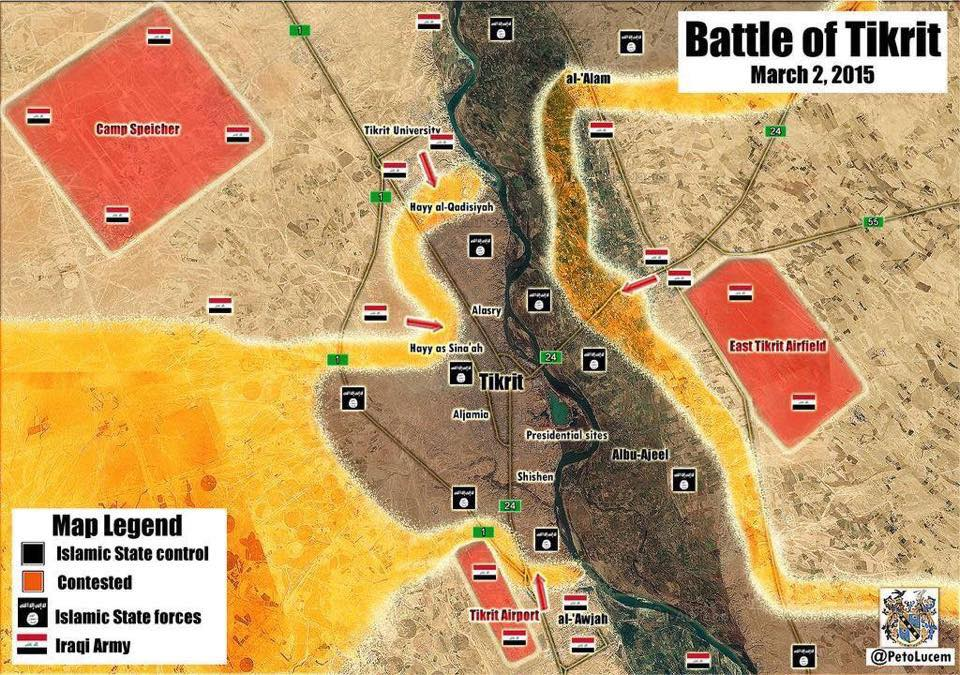As the US Congress debates a war authorization against ISIS, Iraqi government forces and their Shiite militias and Sunni tribal allies have forced their way into the provincial capital Tikrit after a brilliant and massive maneuver that took ISIS by surprise. While ISIS was expecting an advance from the south, the allies came from the north, the west and the south, liberating towns and villages on their way to Tikrit.
“ISIS members were surprised by the fighting tactics the security forces employed by engaging them from multiple directions, encircling and surrounding them, leaving the main roads and opening paths through the farms,” said Colonel Mohammed Ibrahim, the spokesperson for the Iraqi federal police.
Related: The Three Hidden Messages Behind ISIS’s Bloody Rampages
Colonel Ibrahim said that Iraqi government forces misled ISIS by circulating news about the supposed point of attack while the real one was carried out with a massive encirclement. They moved from Diyala province, toward Tikrit, cutting ISIS supply lines from the north and the northeast of Tikrit.
“We liberated al-Alam, cutting the roads between Tikrit and Kirkuk. ISIS’s supply of weapons, munition and other logistics were stopped. ISIS’s last weapon was car bombs. They wanted to blow up more than 50 car bombs, but they were surprised with our rockets,” added Colonel Ibrahim.

This was the first time that the Iraqi forces showed their mettle. They outwitted the jihadists with a well-designed strategic plan and executed the plan flawlessly. In the past, confronted with an aggressive enemy, the Iraqis would have cut and run. Not anymore. This victory, though modest, is a great motivator to both the military brass and the Iraqi ground troops. They finally look like a winning army.
As the Allies push ISIS out of Salahuddin province to the north of Baghdad, many ISIS fighters are reportedly running away from the battlefield without a fight. A video posted online shows the dejected ISIS fighters. In the video, ISIS members complain of the air raids and the lack of reinforcements.
The Iraqi government operation that started earlier this month is the largest so far against ISIS. More than 23,000 men are participating in it. The aim is to capture Tikrit and other smaller cities, towns and villages in Salahuddin province. When this province is cleared from ISIS, ISIS controlled territories in Iraq will be in two provinces: Nineveh in the north and Anbar in the west. That would be a strategic blow to the terror organization.
Related: ISIS Suffers Heaviest Defeat in Iraq in a Single Day
The US air force did not provide air cover for the Iraqi operation. The American ambassador to Baghdad, Stuart Jones, insisted that the Iraqi government not ask the Americans for help this time. It is widely believed that it is the Iranian and the Shiite militias’ heavy presence that made the Americans decline supporting the Iraqi offensive. As he was preparing a visit to Baghdad, the US Chairman of the Joint Chiefs of Staff, General Martin Dempsey, said he will remind the Iraqis that the US air cover to the north of Tikrit helped in their recent victories -- not the Iranian advisers to the Shiite militias.
The city of al-Dur, to the south of Tikrit and the hometown of the fugitive Ezat al-Duri, Saddam Hussein's former second in command, was liberated first. The village of Albu Ajil, to the east of Tikrit where a hostile tribe lives was cleared as well. 150 ISIS fighters were reportedly stationed there, many of them from the tribe of Albu Ajil. Members of that tribe were accused of participating in the mass murder of up to 1700 Iraqi soldiers in June 2014. Those fighters left the village in another indication of ISIS’s collapse. ISIS’s Twitter accounts were strangely silent during the last few days.

“We have reached a crossroad between Albu Ajil and Tikrit...There is a state of panic and fear among ISIS members. They only have some car bombs and improvised explosive devices. We will enter without resistance since they have fled,” said Karim al-Nuri, spokesperson of the Shiite militias.
The fear from the Shiite militias' acts of revenge was present in Albu Ajil. A video posted online shows Iraqi militia burning houses while a car is passing by and the passengers are encouraging those men to set the houses ablaze.
Related: Why America’s War with ISIS Will Take Years
While al-Nuri is saying ISIS members run from the battlefield, other security officials suggests they have withdrawn and they are regrouping in Tikrit. “After the liberation of al-Dur and Albu Ajil...ISIS withdrew to Tikrit city center to the west of the Tigris. They are stationed now in several government buildings...their suicide bombers were distributed on several main streets. Their control and command headquarters are now in the medical college compound,” said Hisham al-Hashimi, the security analyst at the Iraqi national security advisor office.
Whether they fled their positions or withdrew, this is a rare move. ISIS fighters are well known for fighting to the last man. The war has started to break the terror state. Al-Hashimi said that ISIS lost an entire battalion of suicide bombers in the fight around Tikrit. More than 1000 improvised explosive devices were found ready to explode in Tikrit alone.
Faced with the standard ISIS defensive tactics: car bombs, booby-trapped houses and buildings, suicide bombers, improvised explosive devices, sniper fire, or oil fields on fire, the Iraqi government forces and their allies pushed slowly. However, the Iraqi government forces were ready for them this time. “We were able to liberate al-Alam after some fierce fighting. ISIS’s tactics of booby trapping the roads, and leaving snipers and some cars with some machine guns on top of them become old for us,” added Colonel Ibrahim.
In al-Alam, where the famous Iraqi women rights activist Omaya al-Jbara was killed while fighting ISIS last year, the people welcomed the liberating forces. A video posted online shows the joy of ridding the town from ISIS. The liberating forces prayed on her grave to thank Allah for victory.
Related: ISIS Destroys Second Largest Museum in Iraq
As they were honoring the late legendary woman, a new legend was created. An Iraqi version of the American sniper Chris Kyle is now the center of fascination among Iraqis. Abu Azraeil or the father of angel of death is an Iraqi athlete who is now topping ISIS’s wanted list of enemies. He used to be a champion in shooting and in Taekwondo. He joined the Shiite militia and rose up to be the best sniper they have.

Seizing upon a rare chance of ISIS weakness, the Kurdish peshmerga launched a large offensive against ISIS controlled territories in Kirkuk province. More than 100 ISIS fighters were killed, the Kurds claimed. Again, reports of ISIS fighters deserting their positions from the city of al-Hawija by the dozen appeared. Al-Hawija is an ISIS stronghold and a strategic reserve center for ISIS men and weapons. It is now surrounded by the Kurds in Kirkuk and the Iraqi government forces in Tikrit.
In Anbar province, western Iraq, the Iraqi government forces and the Sunni tribes launched several successful offensives as well. The town of al-Baghdadi was restored from ISIS. An Iraqi airbase is located a few miles from the town. More than 300 US military advisors are stationed there to support the Iraqi army with training and air raid coordination. A sector of the provincial capital Ramadi was recaptured as well. Another push was aimed at the insurgent friendly town of al-Garma, near Fallujah. The Iraqi government said they have killed 350 ISIS fighters in the battle of al-Garma alone -- 382 improvised explosive devices, 81 booby trapped houses and 37 ISIS locations were destroyed. But these successes were not without a price. The commander of the Iraqi seventh division that operates in Anbar was injured in action.
ISIS didn't sit idle. While it was losing in Tikrit, it launched a massive attack in al-Ramadi on Wednesday. “17 suicide attackers driving car bombs attacked the Iraqi army there. Forty-one ISIS fighters were killed,” said Saadon Shehan, a blogger from Ramadi. The Iraqi army managed to control the situation there.
To the north of Tikrit, ISIS continues to destroy Nineveh and Mosul infrastructure and landmarks. After the library, the museum and the wall of Nineveh, ISIS destroyed the Mosul airport and several other buildings that were used by the Iraqi army prior to its capture of the city in June 2014. Even the city bridges were reported to be booby trapped, so they would be blown away once an offensive starts on Mosul. The thousand-year old sites of Nimrud, Hatra and Pursiba were all leveled.
Top Reads from The Fiscal Times:





